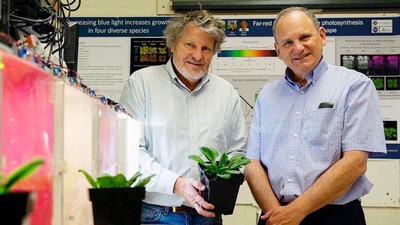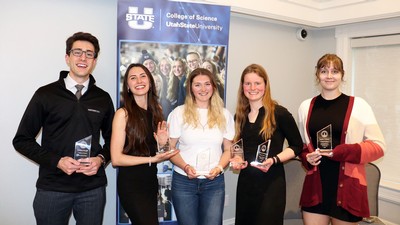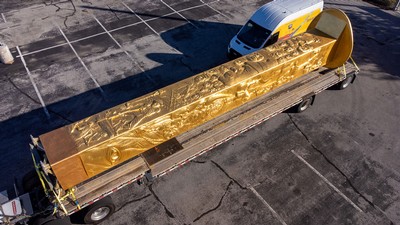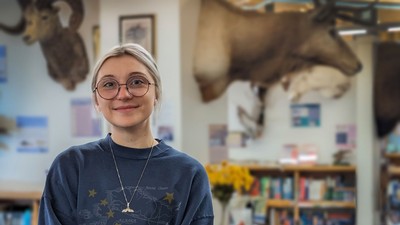USU Cadaver Lab Tours: The Dead Teach the Living, But the Living Help, Too
Biology's Andy Anderson and his volunteer team of students and alumni offer a unique learning, outreach and recruiting opportunity.
By Mary-Ann Muffoletto |
Video by Taylor Emerson, Digital Journalist, University Marketing and Communications
As Utah State University scholars pursue a busy and varied schedule of spring semester classes, labs, activities and events, university recruiters are welcoming eager high schoolers to campus, hoping to instill the same excitement that convinced previous freshmen to become Aggies.
Among the most popular stops on campus tours is the Department of Biology’s Cadaver Lab, where principal lecturer and pre-health advisor Andy Anderson and his volunteer team of student and alumni helpers — known as the USU Cadaver Tour Club — offer a unique and somewhat unusual glimpse of campus study. In addition to high school students, the club welcomes health care professionals-in-training, including emergency medical technicians, paramedics, certified nursing assistants, medical assistants and yoga instructors, to view the lab’s human bodies donated for learning and research.
“Each week, I receive multiple appreciative emails from people in the broader community who have visited the lab and had such a rewarding experience,” says Biology Department Head Diane Alston.
Among the lab’s enthusiastic fans is USU Admissions Campus Tour Coordinator Maggie Porter.
“I advise a group of student ambassadors and, during training, the number one thing they want to tour on campus is the cadaver lab,” Porter says. “I’m also so appreciative of Andy Anderson and his willingness to accommodate hundreds of prospective students and other visitors with lab tours. I love the passion he has for this program and his desire to educate each person who comes into the lab.”
Most cadaver club members, thoroughly trained by Anderson, are preparing to apply to medical school, dental school or other competitive health profession programs. Volunteering to lead tours provides an excellent tutorial of anatomy and physiology.
“It really helps to solidify your knowledge,” says Jeremy Oliphant, who in addition to leading tours has served as a teaching assistant for Anderson’s classes for six semesters. “But it’s also gratifying to see young students experience the lab and see their interest in science come alive. Seeing the cadavers also reveals that though we may seem different on the outside, we’re all really the same on the inside.”
Anderson says the volunteers also benefit from the opportunity to hone their communications skills.
“As medical professionals, these scholars will be called on to communicate complex information clearly and effectively with the public,” he says. “They’ll also need to convey difficult and sometimes distressing information to patients and their loved ones. Volunteering in the lab is a good way to gain experience.”
Anderson’s lab prominently displays the sign “Mortui Vivos Docent,” a Latin phrase, oft-quoted in cadaver labs around the world, meaning, “The Dead Teach the Living.”
Acknowledging some fear, reluctance and concern about the appropriateness of studying dead bodies, Anderson reassures first-time lab visitors the cadavers serve a noble purpose.
“These cadavers represent people who willed their bodies to science and learning,” Anderson says. “Their loved ones have entrusted these gifts to our care and effort, and the way we pay them back is to get as much educational benefit from these cadavers as we can.”
Anderson receives a new set of cadavers at the beginning of each academic year. Seeking to generate as much learning mileage as possible from each body, he assigns teams of students in his Fall Semester Human Dissection classes to specific cadavers and has each team dissect the specimen in a way that displays a different physiological system. One cadaver, for example, displays the digestive system with intestines unwound and easily viewable. Another displays the nervous system, featuring a brain and spinal cord that can be handled by gloved visitors.
Health education teacher Brad Nelson, of Utah’s Logan High School, and his students are among learners benefiting from the lab tours.
“Visiting USU’s cadaver lab is an amazing experience for our students,” says Nelson, who brings several classes to the lab each year. “Some might be timid and shocked at first, but it’s an experience they continue to talk about. Looking at colored illustrations in a textbook just isn’t the same as getting to look at actual bodies.”
Encouraged by Oliphant and fellow tour guide volunteers, Nelson’s teen students gathered around the lab’s cadavers during a recent visit.
“This is a ‘touch’ lab, so touch all you want,” said cadaver tour guide and USU alumna Kelli Fife ’04, a retired physician assistant, as she quizzed the teens about muscle groups. “The last wish of these individuals is that you’ll learn from them.”
Tour guide and alum Björn Rodriguez ’20, a second-year medical student at St. George’s University School of Medicine, asked a group of teens to identify the abdominal aorta.
“It supplies blood to your stomach, pelvis and legs,” Rodriguez said. “If a person suffers an abdominal aorta rupture, they can bleed out and die.”
In another group, guide and alumna Jayme Warner ’20, a staff sergeant in the Utah Air National Guard, asked students to name the pouch-like junction between the small and large intestines.
“Does anyone know the name of this?” she asked. “It’s the cecum.”
Warner, who plans to apply to medical school, hopes the teens’ visit will spark their interest in science and pursuing higher education.
“I never did anything like this in high school,” she says. “I think visiting a lab like this makes a big impression on teens and lets them see opportunities for further study.”
Andy Anderson shows a human heart to USU Cadaver Lab visitors. He welcomes hundreds of guests each year, to ensure as many learning opportunities as possible from the donor specimens. (Photo: M. Muffoletto)
WRITER
Mary-Ann Muffoletto
Public Relations Specialist
College of Science
435-797-3517
maryann.muffoletto@usu.edu
CONTACT
Andy Anderson
Principal Lecturer and Pre-Health Advisor
Department of Biology
435-797-1913
andy.anderson@usu.edu
TOPICS
Biology 166stories STEM 165stories Teaching 153storiesComments and questions regarding this article may be directed to the contact person listed on this page.







